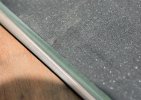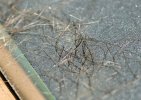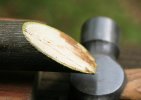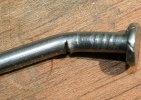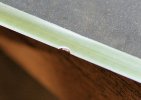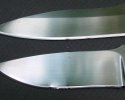I have a couple of questions about my newly aquired machette, it's a Brazillian 'Tramontina', cheap and cheerful, complete with PVC sheath! Holds a fair edge and claims a carbon steel blade. I would like to know if the blade should be sharpened to the same angle throughout it's length or, is it similar to the Parang where only the extreme ends are finely honed and the mid section of the blade is fairly sharp for splitting wood etc. How close to the tip of the blade should be sharp? Mine has no edge whatsoever at the tip. Any info about machettes will be gratefully received. Thanks.
-
The BladeForums.com 2024 Traditional Knife is ready to order! See this thread for details: https://www.bladeforums.com/threads/bladeforums-2024-traditional-knife.2003187/
Price is$300$250 ea (shipped within CONUS). If you live outside the US, I will contact you after your order for extra shipping charges.
Order here: https://www.bladeforums.com/help/2024-traditional/ - Order as many as you like, we have plenty.
You are using an out of date browser. It may not display this or other websites correctly.
You should upgrade or use an alternative browser.
You should upgrade or use an alternative browser.
Machette sharpening
- Thread starter Gruesome
- Start date
Congrats on your new acquisition! I have one myself. What I did to sharpen mine was I used a sander and put low grit sand paper on it, coarse, and grinded that thing to quite an edge to where I was able to slice up paper! Its carbon steel, so there will be sparks flying. . . .I even did the same thing to my folding military shovel.
Hope this helps.
Mike
Hope this helps.
Mike
Eric Isaacson
Pirate
- Joined
- Dec 19, 1999
- Messages
- 12,547
Welcome to Bladeforums.
You'll probably get more answers in the "Toolshed" so I'll move it over there for you.

You'll probably get more answers in the "Toolshed" so I'll move it over there for you.

I have 2 big Cold Steel Gurkha Kukri blades. I have one HTC (15 inch) and one of the 5/16ths thick, 12 inch models as well. Both are just great for when I do work in the wetlands that I get a lot of duties taking care of. Both blades go through vines like warm butter.
I also have 2 machetes made by Ontario. The method I have found that works the best is doing them with my TORMEK wet grinding machine. What I have done is to take one of the TORMEK grinding stones and I took a diamond stone dresser and I form and radius on one side of the stone. With that radius I can sharpen several different types of curved blades ( especially big ones) and I have really great control when I do it. With the odd shapes of the Gurkha Kukri blades you need something to do the curves with.
Now if you have a machete that has a straight/flat cutting edge then a regular squared off grinding stone does a great job. You can check out the TORMEK units by going to >> www.sharptoolsusa.com <<. They are great people to do business with direct.
I also have 2 machetes made by Ontario. The method I have found that works the best is doing them with my TORMEK wet grinding machine. What I have done is to take one of the TORMEK grinding stones and I took a diamond stone dresser and I form and radius on one side of the stone. With that radius I can sharpen several different types of curved blades ( especially big ones) and I have really great control when I do it. With the odd shapes of the Gurkha Kukri blades you need something to do the curves with.
Now if you have a machete that has a straight/flat cutting edge then a regular squared off grinding stone does a great job. You can check out the TORMEK units by going to >> www.sharptoolsusa.com <<. They are great people to do business with direct.
Esav Benyamin
MidniteSuperMod
- Joined
- Apr 6, 2000
- Messages
- 90,915
Here's advice on sharpening a machete from an expert:
Sharpening the Ontario - Jerry Hossom
http://hossom.com/sharp/
Sharpening the Ontario - Jerry Hossom
http://hossom.com/sharp/
littleriddick
BANNED
- Joined
- May 24, 2007
- Messages
- 56
try sharpening the blade to a 30 degree angle,that is a good hard working angle, it will chip less than if you use that angle as opposed to a 17(razor) 20(still shaving) 25 (still pretty grabby on the fingers) or a 30(good on cardboard,wood(chopping or carving) or skulls. it will not have to be maintained regulary as if you used more extreme angles.
Cliff Stamp
BANNED
- Joined
- Oct 5, 1998
- Messages
- 17,562
Machetes tend to be soft and not chip, generally there is little need to go over 15 degrees unless the wood is really hard or full of knots. I run about 15-20 degrees with a primary of about 10. The cutting performance will be about 2:1 over a 30 degree bevel. This pays off a lot in the long term.
-Cliff
-Cliff
- Joined
- Aug 1, 1999
- Messages
- 3,036
I've sharpened a whole lot of machetes and used one in the military for two years in dense jungle.
Machete steel does chip - you need only examine a well used blade that's cut some hardwood and deadfall to attest to that, but it is soft steel and doesn't tend to produce large chips or cracks. It also will deform if too thin. Ontarios are 1095 steel at ~Rc53. I don't know what Tramontina's are made of or if the steel behaves the same, but I'd guess so. Machetes deliver huge forces to a cut because of their length and the amount of leverage you have, so a stout convex edge will cut well and last a whole lot longer. I agree with Littleriddick, who based on his location is probably not chopping marsh grass.
To answer your question, you can use the same angle for the entire length or use a finer angle for a few inches near the handle for light cutting tasks. Chopping should always be done with the forward half of the blade. Ontarios come with completely dull points, which is probably OK and may even be a safety feature, but I find dull anythings offensive so I sharpen that area to a steeper angle.
Hope that helps.
Machete steel does chip - you need only examine a well used blade that's cut some hardwood and deadfall to attest to that, but it is soft steel and doesn't tend to produce large chips or cracks. It also will deform if too thin. Ontarios are 1095 steel at ~Rc53. I don't know what Tramontina's are made of or if the steel behaves the same, but I'd guess so. Machetes deliver huge forces to a cut because of their length and the amount of leverage you have, so a stout convex edge will cut well and last a whole lot longer. I agree with Littleriddick, who based on his location is probably not chopping marsh grass.
To answer your question, you can use the same angle for the entire length or use a finer angle for a few inches near the handle for light cutting tasks. Chopping should always be done with the forward half of the blade. Ontarios come with completely dull points, which is probably OK and may even be a safety feature, but I find dull anythings offensive so I sharpen that area to a steeper angle.
Hope that helps.
Cliff Stamp
BANNED
- Joined
- Oct 5, 1998
- Messages
- 17,562
Machete steel does chip - you need only examine a well used blade that's cut some hardwood and deadfall to attest to that ...
Properly hardened it won't. If it did then everything would because the toughness of those steels is actually so high that standard knife steel toughness tests can't even measure them as they will be off scale. Thus if a 1050 machete chipped a ATS-34 machete would explode.
The impacts of machetes should never be overly severe because the cutting ability should be very high and thus the impact energy dissipated through the cut length. This is in fact also why the properly optomized edges will be more durable as they are slimmed down. Swaim noted this over ten years ago.
It is also why full size axe heads don't come close to 30 degrees per side, see the Axe Book for example written by a man who spent a lifetime using axes. Arguing a machete needs a similar profile as a full size felling axe is laughable considering the relative impact energies of a 5 lbs and on a three foot handle. Axe profiles by the way are similar to what I noted, 10 primary, with 15 secondary.
The machete profile that I noted in the above are used on seasoned black spruce, oak and other similar woods, hard enough so that at times full penetration is about 1/4" or so on a 2-3" piece of wood. The edges will not ripple on Martindales, Tramontina's etc. . The good ones anyway, there are a lot of defective matches in regards to hardening as they are HIGH volume production.
-Cliff
- Joined
- Aug 1, 1999
- Messages
- 3,036
Well....
Here are some pix of a brief test I did awhile back.
My edge on an Ontario.
My edge having shaved arm hair
A sappling cut by my edge
An 8d nail into which my edge was driven with a hammer.
My edge after failing nail test.
Lots of oak and hickory in GA.
Here are some pix of a brief test I did awhile back.
My edge on an Ontario.
My edge having shaved arm hair
A sappling cut by my edge
An 8d nail into which my edge was driven with a hammer.
My edge after failing nail test.
Lots of oak and hickory in GA.
Attachments
- Joined
- Aug 1, 1999
- Messages
- 3,036
Steel test. Top blade is 154CM @ Rc61, having cut through one of said 8d nails. Edge thickness above bevel is 0.030".
Bottom blade is at same geometry in a different steel at Rc59.5 I was testing for the producer. It didn't quite make it to market.
So much for "exploding" ATS-34 stainless.
Bottom blade is at same geometry in a different steel at Rc59.5 I was testing for the producer. It didn't quite make it to market.
So much for "exploding" ATS-34 stainless.
Attachments
The edge looks more deformed than chipped.
Interesting, I've found some Ontario machetes to be too hard, and to indeed chip before rolling/deforming. Presumably 1095, took a pretty good edge but not as good in the toughness department. The toughest Ontario I have is, oddly enough, an economy model with an extremely acute edge.
Interesting, I've found some Ontario machetes to be too hard, and to indeed chip before rolling/deforming. Presumably 1095, took a pretty good edge but not as good in the toughness department. The toughest Ontario I have is, oddly enough, an economy model with an extremely acute edge.
- Joined
- Aug 1, 1999
- Messages
- 3,036
This one did deform, but that might be a consequence of hitting the nail at 90 degrees. A more angled cut might have caused it to chip. I've seen both forms of failure, as have you apparently. It's not too bad in the toughness department; that is after all a steel nail. Try that cut with a "better" steel sometime. 

